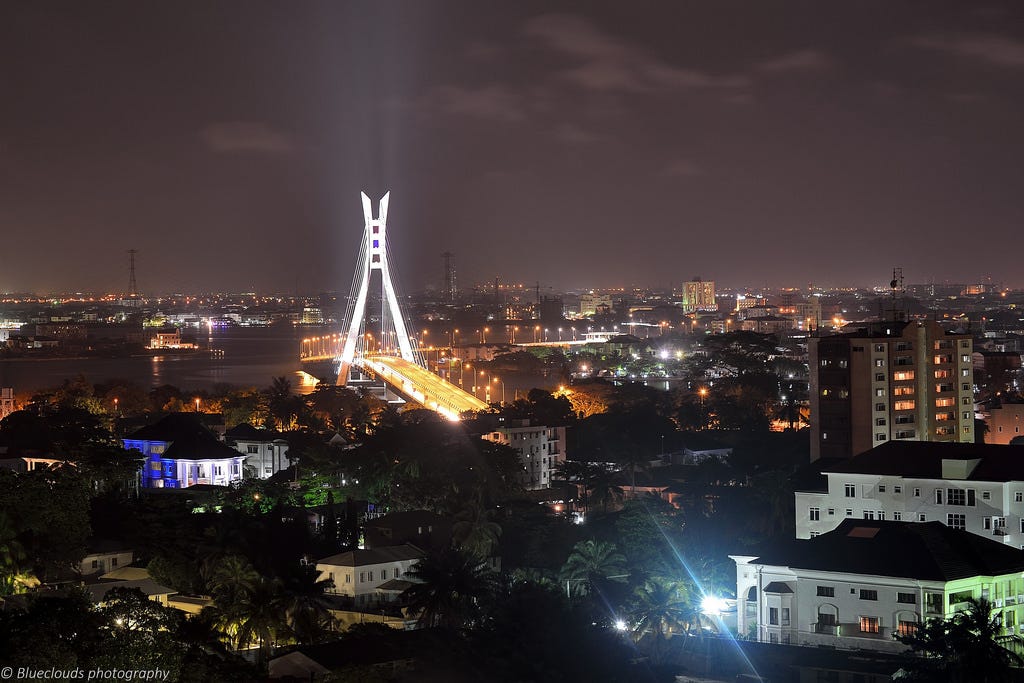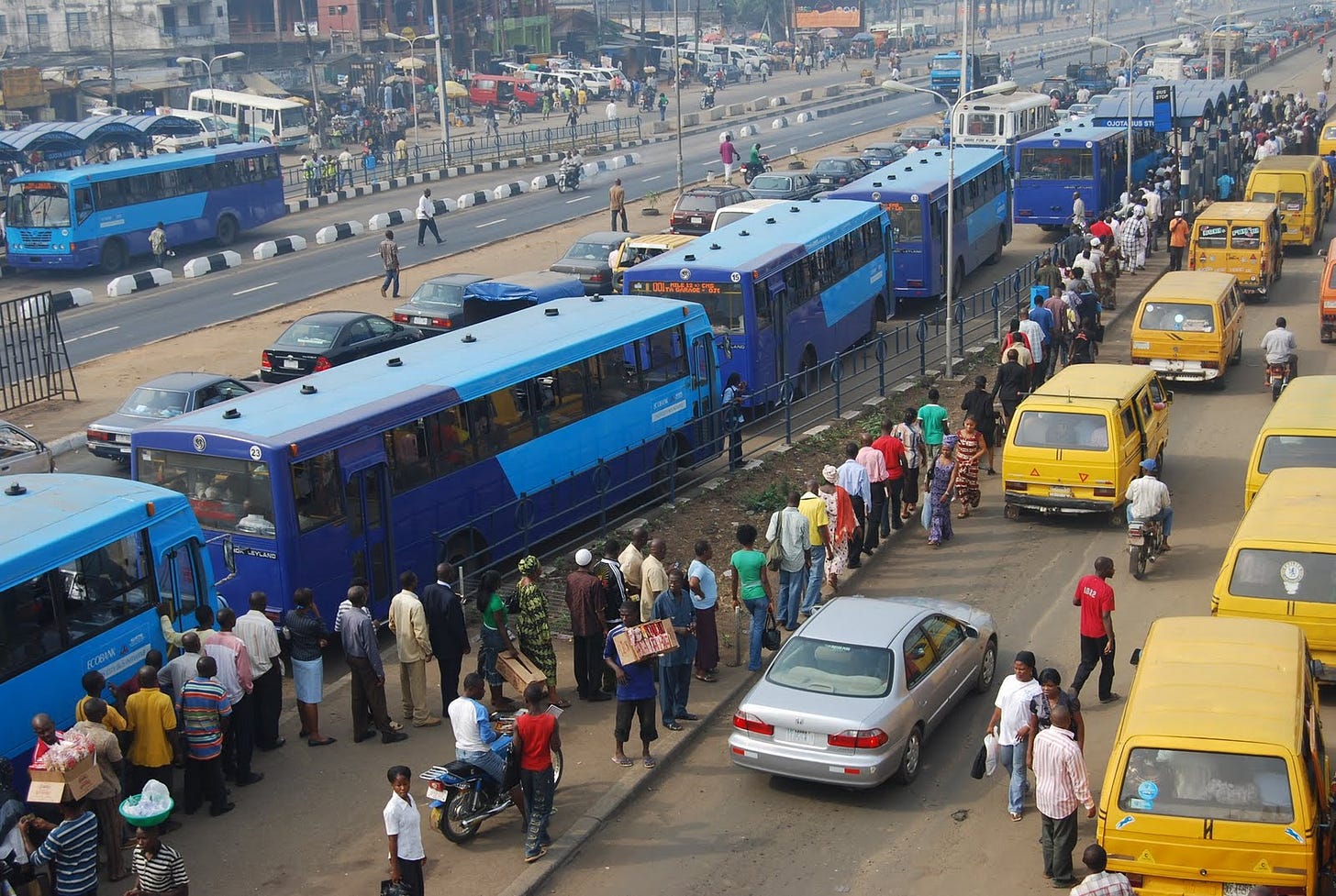Note
Merry belated Christmas, everyone! We wish you and your loved ones a very happy festive season—one that is free from anticompetitive practices.
However, if you have spent the holidays in Lagos, there is an anticompetitive practice whose symptoms may have partially disrupted your Christmas plans. But, you’re in luck because we are bringing you our first ever guest post by Temidayo Alade, who reveals and (hopefully) resolves that very practice. Temidayo has an LL.M from the London School of Economics, in Competition and Economic Regulation. And before this, he was an Associate at Olaniwun Ajayi LP, in the Dispute Resolution and Regulatory Consulting practice of the firm.
As always, thank you for your support, and we hope you enjoy this week’s article.
Guest post – Can competition law solve Lagos traffic?
Lagos is the sixth-largest city globally and faces the urgent challenge of developing a transport system that can meet the needs of a growing urban population and facilitate continued economic growth.

In Lagos, bus transportation is the most frequently used mode of transportation.1 However, the inadequate fleets of public transport buses to service the Lagos population and the dilapidated road networks cause the population to seek other (more efficient) modes of road transport. As such, the lack of buses has led to more cars on Lagos’ roads, which causes traffic gridlock daily, particularly from the Lagos mainland to Lagos Island.2
The inadequacy of Lagos’ road network, i.e., short road length relative to the population, a limited number of multilane arterial roads, generally poor road maintenance, and the relatively high level of car ownership, have exacerbated the State’s traffic congestion. Commuters in Lagos spend up to 75% of their weekly working hours sitting in traffic,3 which is unsustainable. Without a doubt, the current transport regime in Lagos cannot meet the demands of its booming populace.
Whilst Lagos is really late to the party regarding train infrastructure for travel, Lagos was relatively early (considering ‘African Time’) in using Bus Rapid Transit as a means of transportation. ‘BRT’ is a new breed of urban passenger road transportation with an emerging global presence due to evidence of its efficiency in improving mass transportation capacity quickly and at a low-to-moderate cost. As distinct from regular and express bus services, the BRT system operates a rail-like structure on road infrastructure, to separate regular vehicle traffic through concrete tracks erected on major roads to provide a clear narrow right of way to BRT Buses.

The cost-effectiveness advantage has made the BRT system accessible to budget-constrained cities that cannot afford rail transit and has become very popular in many countries—e.g., Colombia, Brazil, Chile, Mexico, Canada, United Kingdom, Indonesia, India, Japan, Thailand, China, France, Netherlands, and South Africa.
What has competition law got to do with anything?
The BRT system presents a natural monopoly problem in competition law, which does not allow for free flow of market competition. A natural monopoly, in simple terms, typically occurs when the amount of investment and infrastructure required to operate in an industry is so huge compared to the cost of the service being rendered or the product being supplied. This makes it infeasible for potential industry players to undertake similar investments to produce a competing product or service. In these situations, either only one player services the market, or competition law makes this industry player grant access to its infrastructure to other players to produce a competing product or service.
In BRT systems, because only the government can partition the BRT track on existing roads, and construct BRT infrastructure, only the government has the right, authority, and perhaps investment capacity due to control of major roads, to run a BRT system. According to an evaluation of Lagos’ BRT system from the fall of 2008,4 the BRT system was said to be efficient to Lagos users as it saved time, was relatively direct to desired destinations, and affordable. However, there have been significant delays in the commissioning and development of routes relative to consumer demand and there are an insufficient number of buses to serve customer demand, resulting in inefficiencies within the system. In general, the lack of competition within the system to drive innovation and market efficiency has created a dilapidated BRT network.
In conventional bus transportation, natural monopolies are non-existent in the navigation of travel routes. The market is accessible for conventional bus transport on procurement of travel buses, and the competitive advantage depends on the bus operator’s service offering, including bus fares, routes, and additional customer welfare packages. Conventional bus routes are not exclusive, and each operator has a level playing field in riding on the road infrastructure alongside vehicle traffic to meet consumer demand. The yellow and black (otherwise known as ‘danfo’) buses in Lagos, exhibit the same competitive freedom; however, from experience, it is safe to say that there is no unique competitive service offering amongst these yellow and black buses, apart from the mood of the bus drivers, their choice of stickers, and their ability to manipulate traffic (most times illegally) to get to our destination.

So, what can competition law do?
The Lagos transportation sector is mainly government-led, with private actors participating in the market either based on government franchises or licensing.5 The Lagos State government solely controls the construction of the BRT network, and interested industry players may only run their operation strictly in line with the scheduling, routes, pricing, and modes prescribed by the Lagos State government. Because of this very rigid model, Lagos’ BRT system does not feature any competition and commuters are limited strictly to only what the government offers.
Competition law, to break this natural monopoly, and improve efficiency, allows for a different regulation system. This could involve separating the natural monopoly features of the BRT system from its competitive dimensions. Hence, the operator of the BRT infrastructure (the Lagos State government) is removed from solely providing and running the BRT bus services, and does not compete at this level. Private investors should be allowed to enter the BRT industry, and compete with each other and the Lagos State government, using the infrastructure provided by the Lagos State government. This will boost innovation in route scheduling, pricing, comfort, bus timing, etc., as the attractiveness of each competitor and their profit, will be based on their service offering.
Following the innovation that will be introduced by the free flow of competition, this could reduce the number of cars on Lagos’ roads, as there will more efficiency and accuracy in transportation times on the roads using the BRT, similar to train network transport. This mode of regulation is typically referred to as a ‘vertical separation model’ of the market and includes dividing the role of the regulator in the market from the competitive segments of the industry,6 which is then opened to different players for market efficiency. This model will be different from the franchise model currently used in Lagos, which reduces the flexibility of interested industry players, and tilts towards a concession model that allows interested competitors to provide transportation services; however, this must be in line with contractually agreed entry and operation requirements prescribed by the Lagos State government.
This model is currently used in countries like Colombia, which has the largest and most efficient BRT system in the world, and should be considered in Lagos. And, maybe, just maybe, Lagos residents would not have to head towards their destinations 5 hours earlier than their scheduled appointment time because of the Legendary Lagos Traffic.
Before you go…
…here are some recent developments in the world of competition law:
New Chief, who dis: The Common Market for Eastern and Southern Africa’s (COMESA) Competition Commission (CCC) has a new Chief Executive, Dr Willard Mwemba. On World Competition Day, December 5th, he gave a short address wherein he laid down his vision for antitrust policy in COMESA. Among other things, he mentioned anticompetitive practices that the CCC would focus on, as well as merger control, amending some regulations, and engaging with important groups and stakeholders. You can check out the full address in the video below:
Drop your prices: South Africa’s Competition Commission (SACC) has gone after laboratories for charging extortionate prices for COVID-19 tests. After an investigation, the SACC was able to get three major labs—Pathcare, Ampath and Lancet—to agree to reduce the prices of their PCR tests from 850 rand ($54) to no more than 500 rand ($32). In the course of that investigation, it discovered a similar problem with rapid antigen tests, and got the same labs to reduce the prices of their rapid antigen tests from 350 rand ($22) to no more than 150 rand ($9). Now, all three labs must submit their financial statements every three months to allow the SACC to monitor their prices. Huge success. Interestingly, the SACC chose not to fine these labs, but instead agreed to a less adversarial, consensual agreement.
Amazon in Italy: Italy’s competition authority, the AGCM, has fined Amazon €1.13 billion for abusing its dominant position. According to the AGCM, Amazon was forcefully nudging sellers to use its logistics services, instead of competing services, which harmed competitors in the e-commerce logistics service space. But, surprise surprise, Amazon has disagreed with this characterisation and has stated its intention to appeal the decision. Note that, as of last year, the European Commission began investigating Amazon for the same abuse. How does the saying go again? Ah, yes: there’s no smoke without fire.
Nwafor & Onya, ‘Road transportation service in Nigeria: problems and prospects’ [2019] 4(3) Adv. J. Econ. Mark. Res. 104–117.
Oni, ‘Development of Urban Transportation. In Vandu-Chikolo et al. (Eds.), Perspectives on Urban Transportation in Nigeria. Zaria: Nigerian Institute of Transport Technology’ [2004] pages 53-69.
Obi, ‘Lagos commuters lose 75% of weekly working hours to traffic’ [2018] accessible on Business Day.
Mobereola, ‘Lagos Bus Rapid Transit: Africa’s First BRT Scheme’ [2009] SSATP Discussion Paper No. 9 on Urban Transport Series, accessible on SSATP.
Section 13 of the Lagos Metropolitan Area Authority law empowers the operation of a franchise regime in the public sector led transportation system. Section 13 details that LAMATA may grant a franchise for scheduled bus services and other modes of transportation within the state. Section 13(2) goes further to prohibit a scheduled bus service operation except under the terms of a franchise granted by LAMATA and restricts competition from a mode of transportation in contravention or in competition with a franchise granted LAMATA.
See this article from ‘Damola Adediji and Folakunmi Pinheiro which argues for the same model to be applied to the Nigerian Postal Service in the courier service market: Wake Up, NIPOST! It’s Antitrust O’Clock!




This is a well articulated piece. I hope the Lagos State government get to see this and adopt the plans therein. Lagos will be a much better city with less traffic. Bravo 👍🏼
This is an interesting piece! It got me thinking about the possibilities that can be unlocked around lagos traffic.. Are you open to having a one on one to further discuss this topic? I look forward to reading more from you. Thank you!